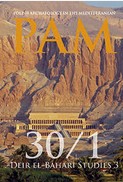Un édifice au nom du roi Héqataoui (Ahmosé Ier) dans la nécropole thébaine
A building in the name of King Heqataoui (Ahmose I) in the Theban necropolis
Author(s): Frédéric ColinSubject(s): Archaeology, Cultural history, Local History / Microhistory, Ancient World
Published by: Wydawnictwa Uniwersytetu Warszawskiego
Keywords: Ahmose; Asasif; necropolis;
Summary/Abstract: While there is massive evidence of the mortuary cult of Ahmose I’s family at Abydos, in the form of pyramids, cult buildings and texts, the Theban necropolis is virtually devoid of archaeological testimony on the building activities of the founder of the Eighteenth Dynasty. However, the king’s mummy was discovered in Thebes, in the royal cache (TT 320), together with other members of his entourage. This apparent paradox is puzzling and has indeed inspired various hypotheses to explain this split in the documentation between Thebes and Abydos. The discovery in 2019 of nine mudbricks stamped with the name of a king, called simply HqA tA.wy, in the French excavations in al-Asasif, provided new data to resolve this question. This paper aims to support the identification of King Ahmose as the author of these bricks and to shed light on the ideological value of this eponymous title, based on the analysis of a key passage in the Ahmose Stele from Karnak (Cairo Museum, CGC 34001). It will also discuss the issue of the displacement of materials and royal bodies organised by the public authorities and search for a possible initial burial context of Ahmose’s mummy in light of new evidence of his building activities in the necropolis of the Theban Residence.
Journal: Polish Archaeology in the Mediterranean
- Issue Year: 1/2021
- Issue No: XXX
- Page Range: 17-48
- Page Count: 32
- Language: French

